Be careful for what you ask, goats are all around, just saying.Yeah - sorry. I hadn't logged in when I initially replied and my autofill picked the wrong email. I've asked that the duplicate be deleted.
You are using an out of date browser. It may not display this or other websites correctly.
You should upgrade or use an alternative browser.
You should upgrade or use an alternative browser.
Homemade Bread Thread
- Thread starter deadfall
- Start date

Help Support Homebrew Talk:
This site may earn a commission from merchant affiliate
links, including eBay, Amazon, and others.
Holy cow, oven spring much man! Beautiful, and I like your poolish makeup, and the use of milk. Is this a particular style - e.g., N. Europe farmhouse tradition, etc.?
Very nice Hanglow, thanks for sharing.
It was just based on a simple 2lb loaf tin recipe. But I was wanting to use a bit less instant yeast, so used a small poolish for the whole grain portion.
My apologizes, I probably should not post when distracted/brewing. I will circle later to see if I can make sense of my previous post.Yeast has maltase, so it can convert to maltose. I think that it also has an invertase but I might be wrong, and that's in the flour. The flour has amylases for conversion as well. It also has proteolytic enzymes.
Not clear on what you're saying here, ba-brewer:
Robert65
Major Obvious (recently promoted)
Yeast has maltase, so it can convert to maltose. I think that it also has an invertase but I might be wrong, and that's in the flour. The flour has amylases for conversion as well. It also has proteolytic enzymes.
Not clear on what you're saying here, ba-brewer:
Yes, yeast does produce its own invertase as well as maltase, and probably some other enzymes we are forgetting about, and of course there are, as you mention, amylases and proteases in the flour.
user 246304
Well-Known Member
- Joined
- Aug 24, 2017
- Messages
- 8,290
- Reaction score
- 9,850
My apologizes, I probably should not post when distracted/brewing. I will circle later to see if I can make sense of my previous post.
No worries, know the feeling!
Very nice Pete!

$53.24
1pc Hose Barb/MFL 1.5" Tri Clamp to Ball Lock Post Liquid Gas Homebrew Kegging Fermentation Parts Brewer Hardware SUS304(Liquid Hose Barb)
yunchengshiyanhuqucuichendianzishangwuyouxiangongsi

$44.99
$49.95
Craft A Brew - Mead Making Kit – Reusable Make Your Own Mead Kit – Yields 1 Gallon of Mead
Craft a Brew

$53.24
1pc Hose Barb/MFL 1.5" Tri Clamp to Ball Lock Post Liquid Gas Homebrew Kegging Fermentation Parts Brewer Hardware SUS304(Gas MFL)
Guangshui Weilu You Trading Co., Ltd

$20.94
$29.99
The Brew Your Own Big Book of Clone Recipes: Featuring 300 Homebrew Recipes from Your Favorite Breweries
Amazon.com

$22.00 ($623.23 / Ounce)
AMZLMPKNTW Ball Lock Sample Faucet 30cm Reinforced Silicone Hose Secondary Fermentation Homebrew Kegging joyful
无为中南商贸有限公司

$176.97
1pc Commercial Keg Manifold 2" Tri Clamp,Ball Lock Tapping Head,Pressure Gauge/Adjustable PRV for Kegging,Fermentation Control
hanhanbaihuoxiaoshoudian

$76.92 ($2,179.04 / Ounce)
Brewing accessories 1.5" Tri Clamp to Ball Lock Post Liquid Gas Homebrew Kegging Fermentation Parts Brewer Hardware SUS304 Brewing accessories(Gas Hose Barb)
chuhanhandianzishangwu

$10.99 ($31.16 / Ounce)
Hornindal Kveik Yeast for Homebrewing - Mead, Cider, Wine, Beer - 10g Packet - Saccharomyces Cerevisiae - Sold by Shadowhive.com
Shadowhive

$7.79 ($7.79 / Count)
Craft A Brew - LalBrew Voss™ - Kveik Ale Yeast - For Craft Lagers - Ingredients for Home Brewing - Beer Making Supplies - (1 Pack)
Craft a Brew

$159.99 ($26.66 / Count)
3M High Flow Series System BREW120-MS, 5616001, For Brewed Coffee and Hot Tea, Valve-in-Head Design
SpaceCityProviders

$58.16
HUIZHUGS Brewing Equipment Keg Ball Lock Faucet 30cm Reinforced Silicone Hose Secondary Fermentation Homebrew Kegging Brewing Equipment
xiangshuizhenzhanglingfengshop

$33.99 ($17.00 / Count)
$41.99 ($21.00 / Count)
2 Pack 1 Gallon Large Fermentation Jars with 3 Airlocks and 2 SCREW Lids(100% Airtight Heavy Duty Lid w Silicone) - Wide Mouth Glass Jars w Scale Mark - Pickle Jars for Sauerkraut, Sourdough Starter
Qianfenie Direct
Looks awesome. Can you (or have you) shared the recipe?View attachment 673455 View attachment 673456 Yeasterdays loaf, the starter was a bit past it prime(started to drop) but wanted fresh bread so used it anyways. Funny how the soft texture continued. Tried a different scoring pattern too.
I do a 1,2,3 ratio of starter,water,flour, light on salt for the wife at 1.7%. That loaf I did a stretch and fold no-knead thing for a couple hours ever 20 to 30mins. Allowed to rest until doubled, then formed into a loaf. Proofed for about hour then baked on a sheet pan at 450F with steam for the first 10min. Removed water and lowered temp to 400F for 20min.Looks awesome. Can you (or have you) shared the recipe?
Below is generic recipe with values for a single loaf, I normally use 1 part king Arthur bread flour and 2 parts king Arthur AP. All AP is good, but all bread flour is a bit dense for me.
So this is the first loaves from the starter I posted the other day. I was going to do a single one pound loaf but forgot to put the starter into the fridge again so did two.
View attachment 559162 View attachment 559163 View attachment 559164 View attachment 559165 View attachment 559166
sort of Italian-ish bread using 1:2:3 start:water:flour
100gm starter
200gm water
300gm king Arthur AP
5gm salt
7gm sugar
15gm extra virgin olive oil


Pizza dough (80% AP Flour & 20% Whole Wheat Flour) portioned and placed in the fridge.
Some bread dough (100% bread flour) resting & rising waiting to be split and baked.
I was curious at Kevin's fast fermentation times - I wonder if it would break down the starches in flour unaided.
I think the major lifting is done my the things added to flour. Some of the pizza flour don't have it and that is why/how they can do the long ferments without it completely loosing it's structure. I know some yeast can convert starch but I don't think it is too common or normal for bread yeast. I had a diastaticus contamination which some can convert starches. That had me looking to see if I was polluting my beer from my sour dough starter. Had my starter tested and it came back negative for diastaticus.
Sorry about the other day, I was brewing and seen the post above by Cock Robin and made a hasty post. My comments were in regard to the yeast breaking down the starches.Yeast has maltase, so it can convert to maltose. I think that it also has an invertase but I might be wrong, and that's in the flour. The flour has amylases for conversion as well. It also has proteolytic enzymes.
Not clear on what you're saying here, ba-brewer:
Most of the yeasts we use for brewing do have the ability to convert starches on their own. One exception is diastaticus variant strains, and not sure if all can. A simple test to check for diastaticus is to add suspect yeast to a starch solution to see if ferments.
The "heavy lifting" of my previous post was referring to the enzymes that are added to white processed flour to get them to break down the starched in a timely manner. Some flour list enzymes in the ingredients but King Arthur flour list malted barley flour.


Playing around, with blue corn flour in this sourdough loaf.
Last edited:
user 246304
Well-Known Member
- Joined
- Aug 24, 2017
- Messages
- 8,290
- Reaction score
- 9,850
Sorry about the other day, I was brewing and seen the post above by Cock Robin and made a hasty post. My comments were in regard to the yeast breaking down the starches.
Most of the yeasts we use for brewing do have the ability to convert starches on their own. One exception is diastaticus variant strains, and not sure if all can. A simple test to check for diastaticus is to add suspect yeast to a starch solution to see if ferments.
The "heavy lifting" of my previous post was referring to the enzymes that are added to white processed flour to get them to break down the starched in a timely manner. Some flour list enzymes in the ingredients but King Arthur flour list malted barley flour.
Had not known or forgot about diastaticus variants - thanks. Just read on WL that many have been more or less normalized as "high attenuators" and others truly are a bad bug in the brewery. Very interesting. I have to dig out some texts again!
Is the added product you're talking about diastatic malt powder? It's interesting to me because you see it used a lot in Raymond Calvel's bible, the Taste of Bread, but particularly when starting up a new levain. I get a lot of flour from Central Milling out of CA, and a lot of the flours they offer are both malted and unmalted of the same variety - e.g., whole malted, whole wheat. I'm getting some malted "Type 85," actually, in a trial of 10#, to compare with my own blend, a calculation meant to approximate the ash (to a lesser extent, extraction) specs of T80 Flour. Many don't like such a high-ash flour as a baseline flour - most prefer a whiter if not truly white flour, but I like the rustic quality of this higher extract "bise" flour, midway between white and whole wheat.
I've never seen much difference in performance between malted and unmalted versions of the same flour.
Thanks for the info!



I need to work on less flour to keep it from sticking but still turned out really well. 100% bread flour.
I believe diastatic malt powder and malted barley flour would be the same thing, but don't really know. I have only used the unmalted flour a couple times for making pizza. It is my understanding it is helpful for the long cold ferments people do with pizza dough. Something about the unmalted flour effecting the browning of pizza crust cooked at lower temp home oven too.Had not known or forgot about diastaticus variants - thanks. Just read on WL that many have been more or less normalized as "high attenuators" and others truly are a bad bug in the brewery. Very interesting. I have to dig out some texts again!
Is the added product you're talking about diastatic malt powder? It's interesting to me because you see it used a lot in Raymond Calvel's bible, the Taste of Bread, but particularly when starting up a new levain. I get a lot of flour from Central Milling out of CA, and a lot of the flours they offer are both malted and unmalted of the same variety - e.g., whole malted, whole wheat. I'm getting some malted "Type 85," actually, in a trial of 10#, to compare with my own blend, a calculation meant to approximate the ash (to a lesser extent, extraction) specs of T80 Flour. Many don't like such a high-ash flour as a baseline flour - most prefer a whiter if not truly white flour, but I like the rustic quality of this higher extract "bise" flour, midway between white and whole wheat.
I've never seen much difference in performance between malted and unmalted versions of the same flour.
Thanks for the info!
After my second contamination that caused a beer to over attenuate and turn phenolic I did some digging into diastatic yeast. Mostly likely I was sloppy with handling of things that came in contact with 3711. It was many months since I used the yeast but I think it might of been the jars I used to store yeast slurry. Some of the diastatic yeasts leave a bio-film and take physical scrubbing to remove and I was not doing that. I have since used a few of the English diastatic yeast without cross contamination but I am more diligent with cleaning and heat sanitize the jars and beakers that are used with those strains.
Robert65
Major Obvious (recently promoted)
Bakers' dry (diastatic) malt powder contains malted barley flour as the "active ingredient," but is cut with plain flour and dextrose. This dilution makes it easier for the manufacturer to standardize, and for the baker to measure, the product.I believe diastatic malt powder and malted barley flour would be the same thing, but don't really know.
Todays loaf came out a little crooked. Mixed and folded last night then put into the fridge overnight for baking today.




The texture of that looks great. And an awesome rise. Your ww loafs always look great. Any thoughts on ratios of ww to white flour. Also was hoping you could lean me in the direction of a serviceable cutter form like yours. There are a lot of options not sure which work. Thanks.
I got the bread slicer from Amazon. It is called "The Bread Pal Bread Slicer, Maple and Birch", by SierraBASE LLC
https://www.amazon.com/Bread-Pal-Sl...Birch+by+SierraBASE+LLC&qid=1585889471&sr=8-3
Robert65
Major Obvious (recently promoted)

Multigrain sandwich loaf, with rye sourdough and a seven grain soaker; more tuna with my feline best friend!


Another loaf this morning. Haven’t cut it open still working on the one from last night.
deadwolfbones
Well-Known Member
Super lazy loaf with 10% dark rye and 10% mixed seeds (white/black sesame and flax). I just mixed everything together at the start—no levain, no autolyse. Just week-old starter straight from the fridge, with an 8-hour bulk fermentation at room temp and then a 17-hour proof in the fridge. Turned out to be my best result yet.
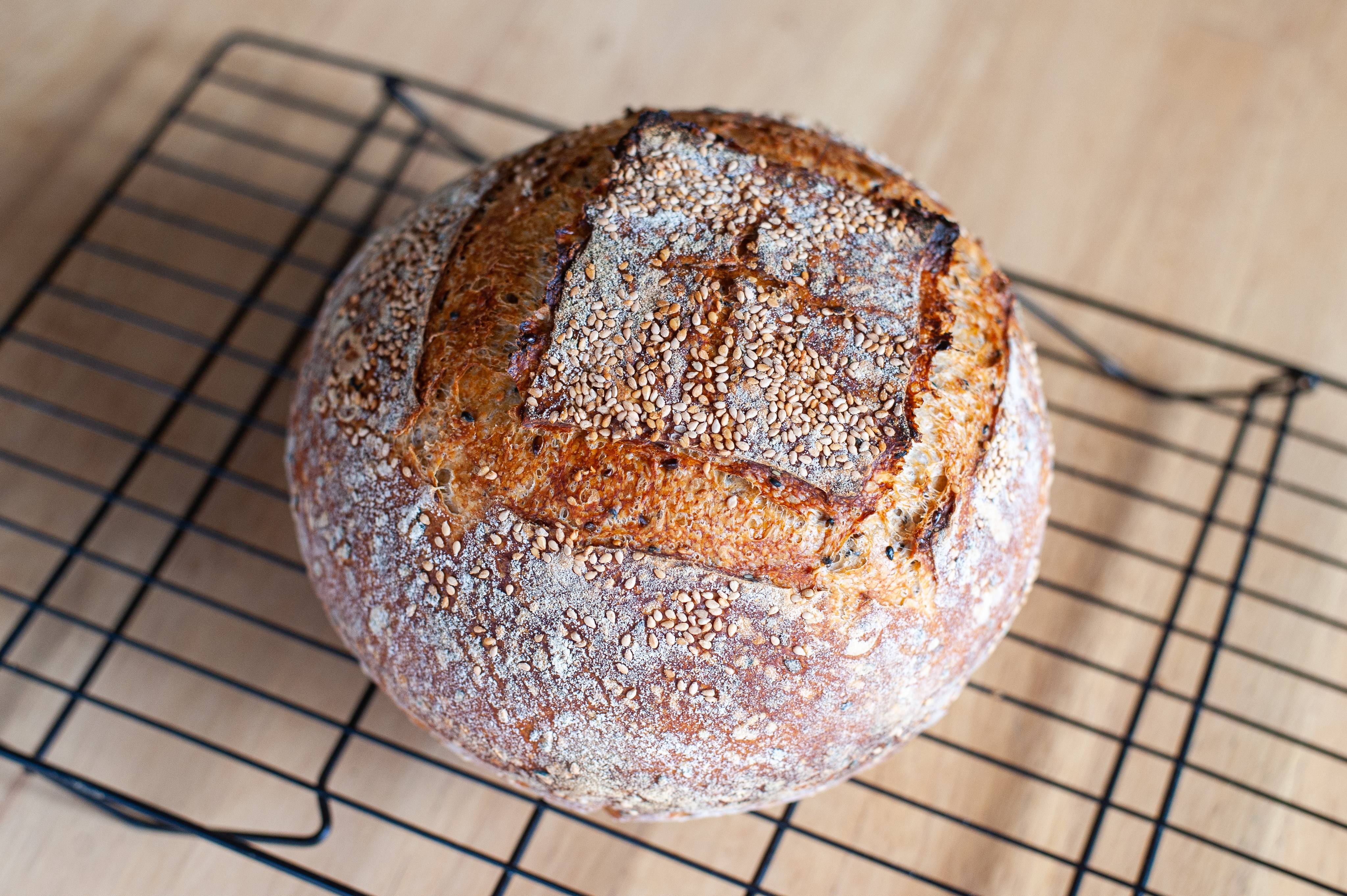
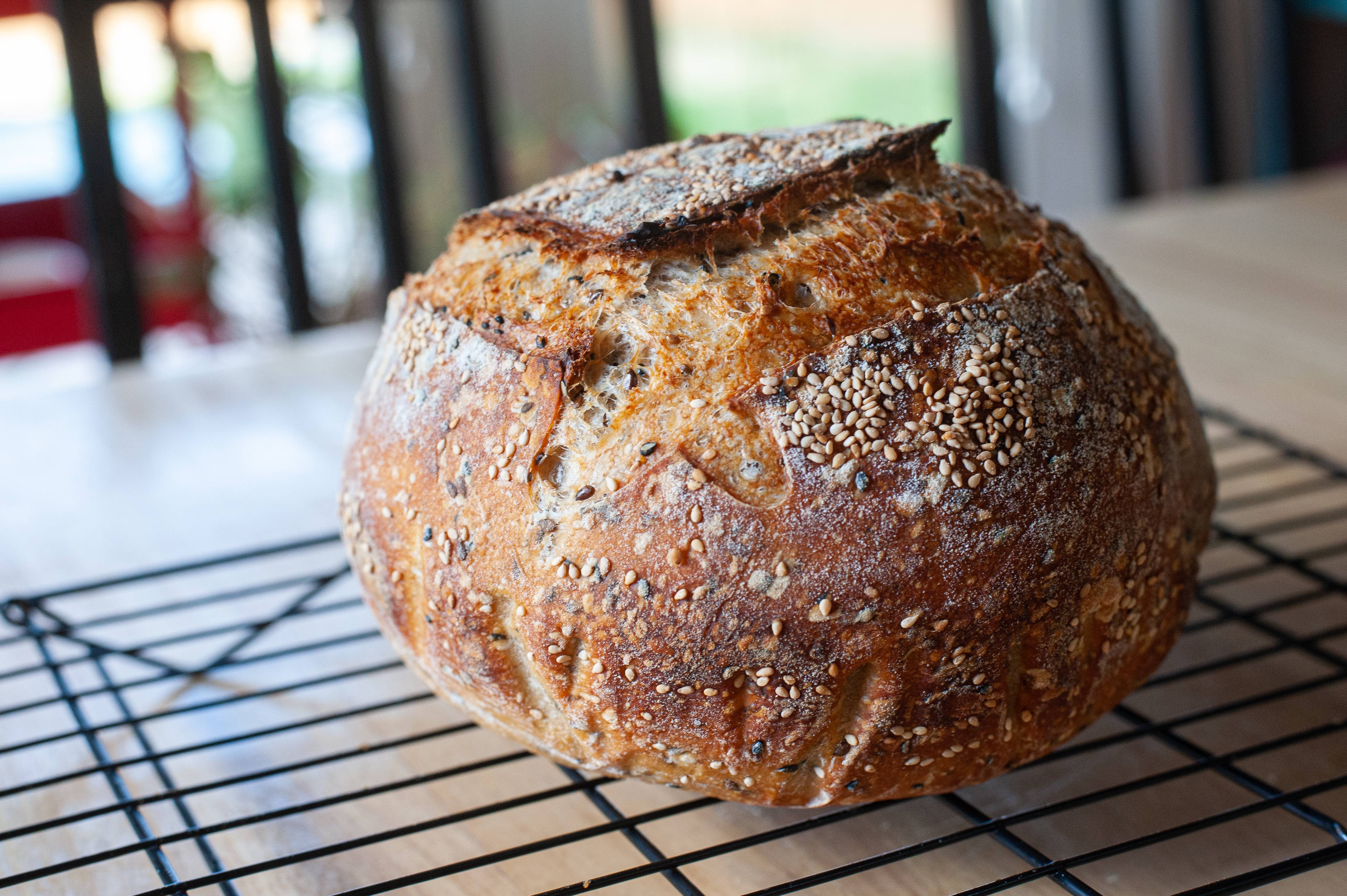
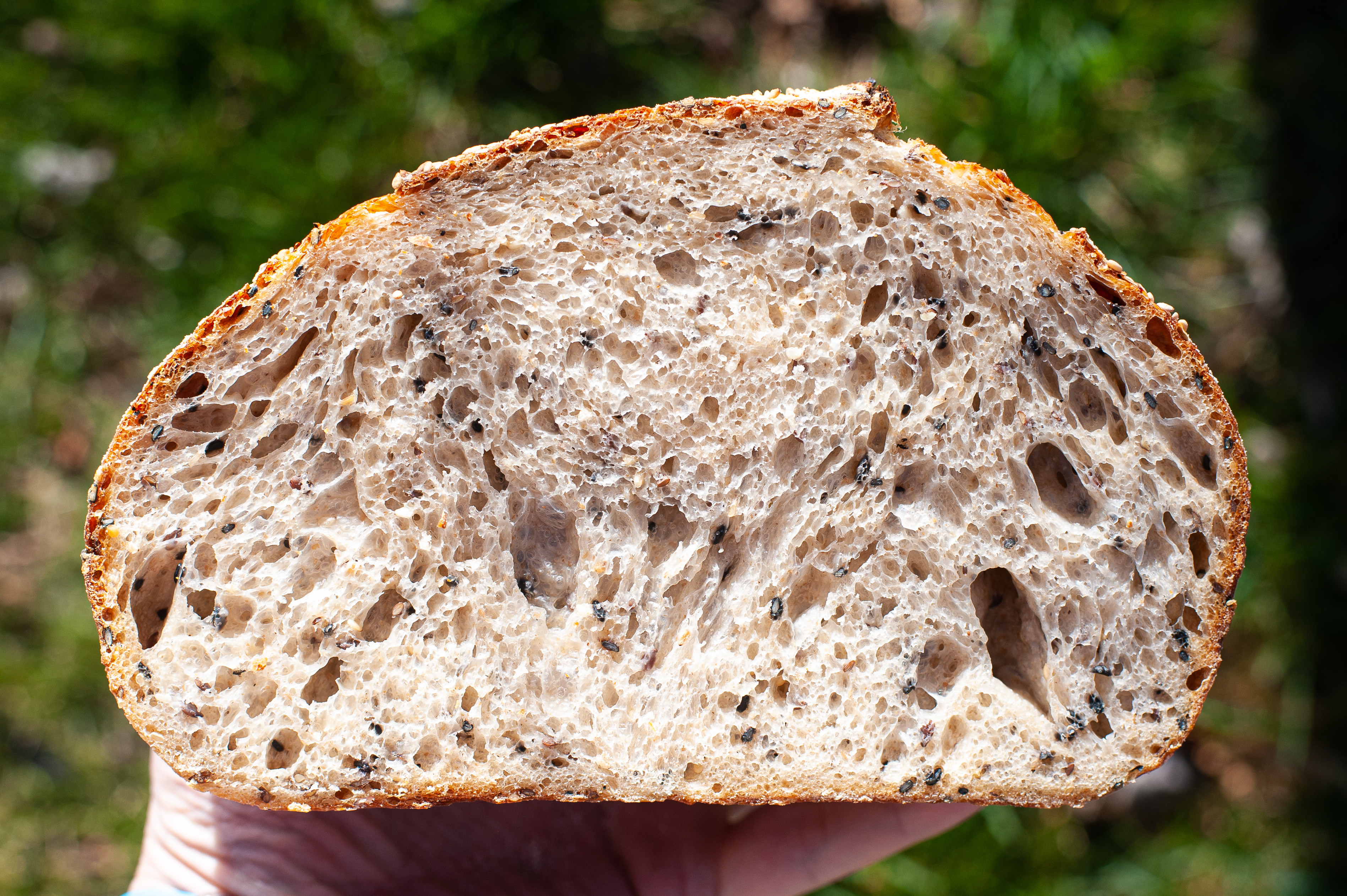



user 246304
Well-Known Member
- Joined
- Aug 24, 2017
- Messages
- 8,290
- Reaction score
- 9,850
Super lazy loaf with 10% dark rye and 10% mixed seeds (white/black sesame and flax). I just mixed everything together at the start—no levain, no autolyse. Just week-old starter straight from the fridge, with an 8-hour bulk fermentation at room temp and then a 17-hour proof in the fridge. Turned out to be my best result yet.



Absolutely stunning. Sounds like you have a greedy little starter culture if it rockets like this with fresh food - beautiful spring and crumb! No cultured yeast - all just levain culture? Well done. One of the most gorgeous looking boules I've seen.
So, dark rye - I use local, comes out to a medium. Mind saying what source you're using for your dark?
And your base flour - was this just an everyday bread flour at 11.7-12.7 or so, or something like the KA "Bread Flour" at 13.7%+?
deadwolfbones
Well-Known Member
Absolutely stunning. Sounds like you have a greedy little starter culture if it rockets like this with fresh food - beautiful spring and crumb! No cultured yeast - all just levain culture? Well done. One of the most gorgeous looking boules I've seen.
So, dark rye - I use local, comes out to a medium. Mind saying what source you're using for your dark?
And your base flour - was this just an everyday bread flour at 11.7-12.7 or so, or something like the KA "Bread Flour" at 13.7%+?
Hey there. Yep! No cultured yeast, just my sourdough culture (actually half and half of two cultures I keep running in parallel, 50g each). My base flour was indeed KA bread flour, and I used Bob's Red Mill for the dark rye.
Thanks for the compliments, btw! I'm really pleased with how it came out, myself.
This is the Instagram post that inspired me to try this technique/recipe: https://www.instagram.com/p/B-cDh2wJiuT/
user 246304
Well-Known Member
- Joined
- Aug 24, 2017
- Messages
- 8,290
- Reaction score
- 9,850
Hey there. Yep! No cultured yeast, just my sourdough culture (actually half and half of two cultures I keep running in parallel, 50g each). My base flour was indeed KA bread flour, and I used Bob's Red Mill for the dark rye.
Thanks for the compliments, btw! I'm really pleased with how it came out, myself.
This is the Instagram post that inspired me to try this technique/recipe: https://www.instagram.com/p/B-cDh2wJiuT/
Awesome, thanks. I'm actually changing up using Beehive at 10.5%, and going with Central Milling's "Baker's Craft Plus" at 11.5%. I used to work almost exclusively with KA Bread Flour and had great results, not sure why I moved on to lower protein levels - might have been something with the chew.
But your loaf is magnificent and I'll be blending my "T80" clone with the Baker's Craft and some KA Bread flour, plus the sifted WW. I'm certain I'll be doing a lot with the KA alone as well. Thanks for the inspiration.
Your two starters in parallel - a wheat and a rye, by any chance? I maintain 3, though I may just bail and build as needed: I maintain a stiff wheat, a liquid rye and a liquid wheat. I may just use the liquid wheat and go from there.
deadwolfbones
Well-Known Member
Your two starters in parallel - a wheat and a rye, by any chance? I maintain 3, though I may just bail and build as needed: I maintain a stiff wheat, a liquid rye and a liquid wheat. I may just use the liquid wheat and go from there.
No, actually... just two different cultures I got from two different friends. Both 100% hydration/AP-based.
Don't tell anyone, but I only started baking in January.
Robert65
Major Obvious (recently promoted)
I maintain 3, though I may just bail and build as needed: I maintain a stiff wheat, a liquid rye and a liquid wheat. I may just use the liquid wheat and go from there.
I used to always have multiples going, but not for a long time. I just have one now, though it readily morphs into different forms. I'm pretty sure this one started (been a long time) as a liquid, all KAF AP. For longer storage, when I'm not baking often, I'll store it as a stiff white sourdough in the fridge (this is also the form I generally use for leavening sourdough-only breads.) It can quickly transition, in a feeding or two, into anything I want, and may spend an extended period being maintained in a different form. If I'm on a rye bread kick, it may live as a Sauerteig, liquid or firm; if I'm just using it as a handy preferment in place of yeasted sponges, it may live in a poolish-like state; sometimes it spends time being fed whole wheat.... As long as I have the culture being kept alive, the details of its daily life seem not to matter much.
Loaf de jour,
user 246304
Well-Known Member
- Joined
- Aug 24, 2017
- Messages
- 8,290
- Reaction score
- 9,850
I used to always have multiples going, but not for a long time. I just have one now, though it readily morphs into different forms. I'm pretty sure this one started (been a long time) as a liquid, all KAF AP. For longer storage, when I'm not baking often, I'll store it as a stiff white sourdough in the fridge (this is also the form I generally use for leavening sourdough-only breads.) It can quickly transition, in a feeding or two, into anything I want, and may spend an extended period being maintained in a different form. If I'm on a rye bread kick, it may live as a Sauerteig, liquid or firm; if I'm just using it as a handy preferment in place of yeasted sponges, it may live in a poolish-like state; sometimes it spends time being fed whole wheat.... As long as I have the culture being kept alive, the details of its daily life seem not to matter much.
I go in phases. I tend to be far too intense about these things (blame my life in French cooking, I guess. Also, don't live as a direct disciple to a Japanese martial and zen master during your 30's desperate spiritual quest), so for years I've tended to maintain all three. Believe it or not, very hard for me to drop to one liquid wheat levain, and morph as needed. On the other hand, I do get sick of tossing so much rye and 50:50 KA AP: WW for refreshments out the door. Like you, I use stiff for my true sourdoughs, and do like a multi-stage build.
I need to sit down with an objective palate and see if I can appreciably distinguish this from a simple overnight preferment with liquid levain.
applescrap
Be the ball!
More of the 50 50 stone ground wheat. Learning it needs a longer proof.






2 cups KA Bread FlourWould you be willing to share the recipe for this wonderful looking cheese bread?
1.5 cups of GM AP flour
2 cups shredded cheese
Canned Jalapeños chopped (~1/4 cup)
1 tbsp of kosher salt
2.25 tpsn of yeast
2 cups of 100f water
Pinch of sugar
I followed the steps of a Tasty post. Let rise for 1 hour, fold. Let rise for thirty, form. I split the mix between two “disposable” tins.
user 246304
Well-Known Member
- Joined
- Aug 24, 2017
- Messages
- 8,290
- Reaction score
- 9,850
Loaf de jour,
Hey Chef - was there an image here? I'm not seeing it....
deadwolfbones
Well-Known Member
Another day, another loaf. Today, 90% KA bread flour + 10% Bob's whole wheat, 2tsp smoked paprika, lots of cracked black pepper, and 90g English coastal cheddar.
Same "quick" process as last time (no levain, no autolyse, 8hr bulk at room temp, 17 hours in fridge).
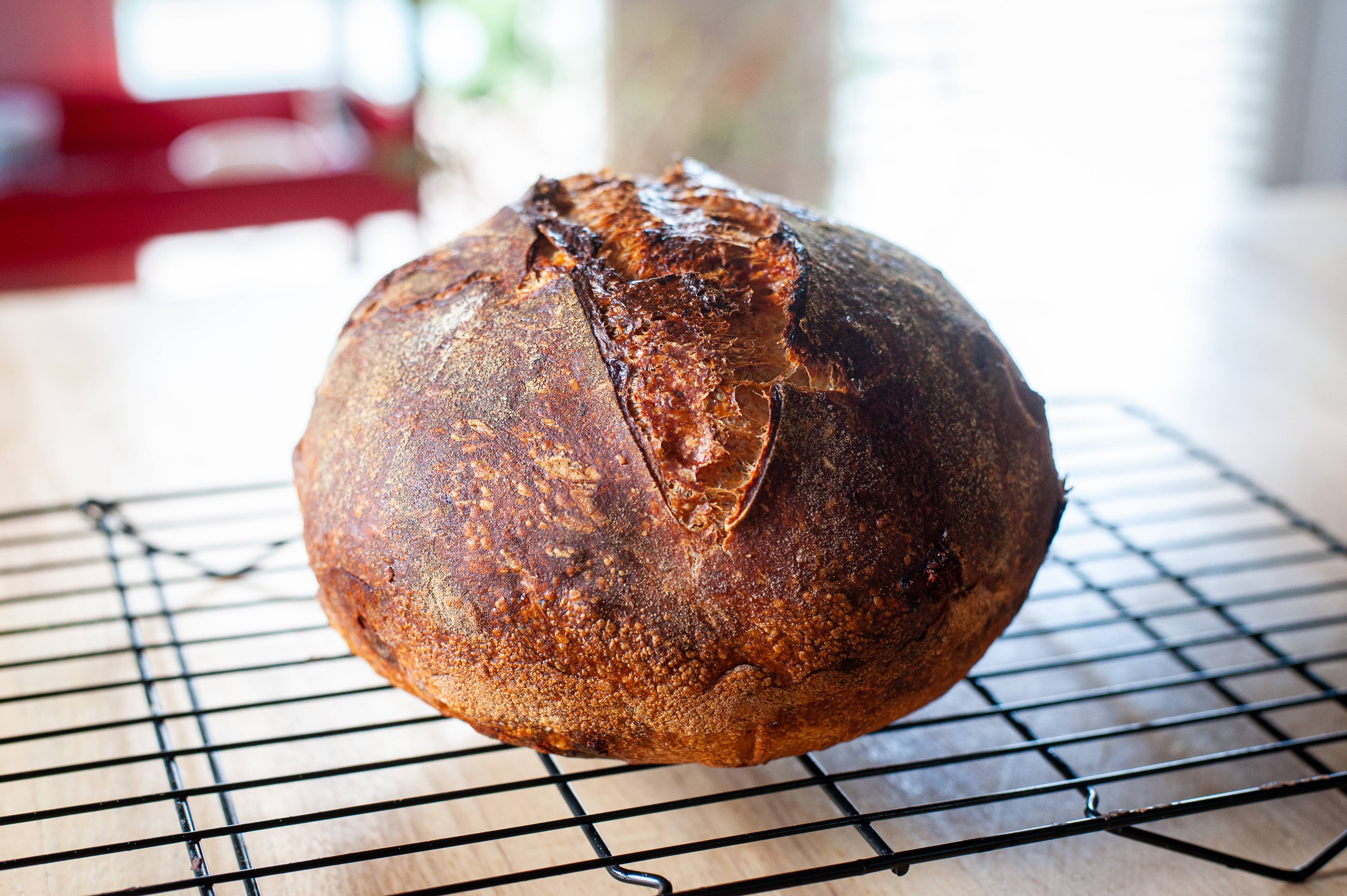
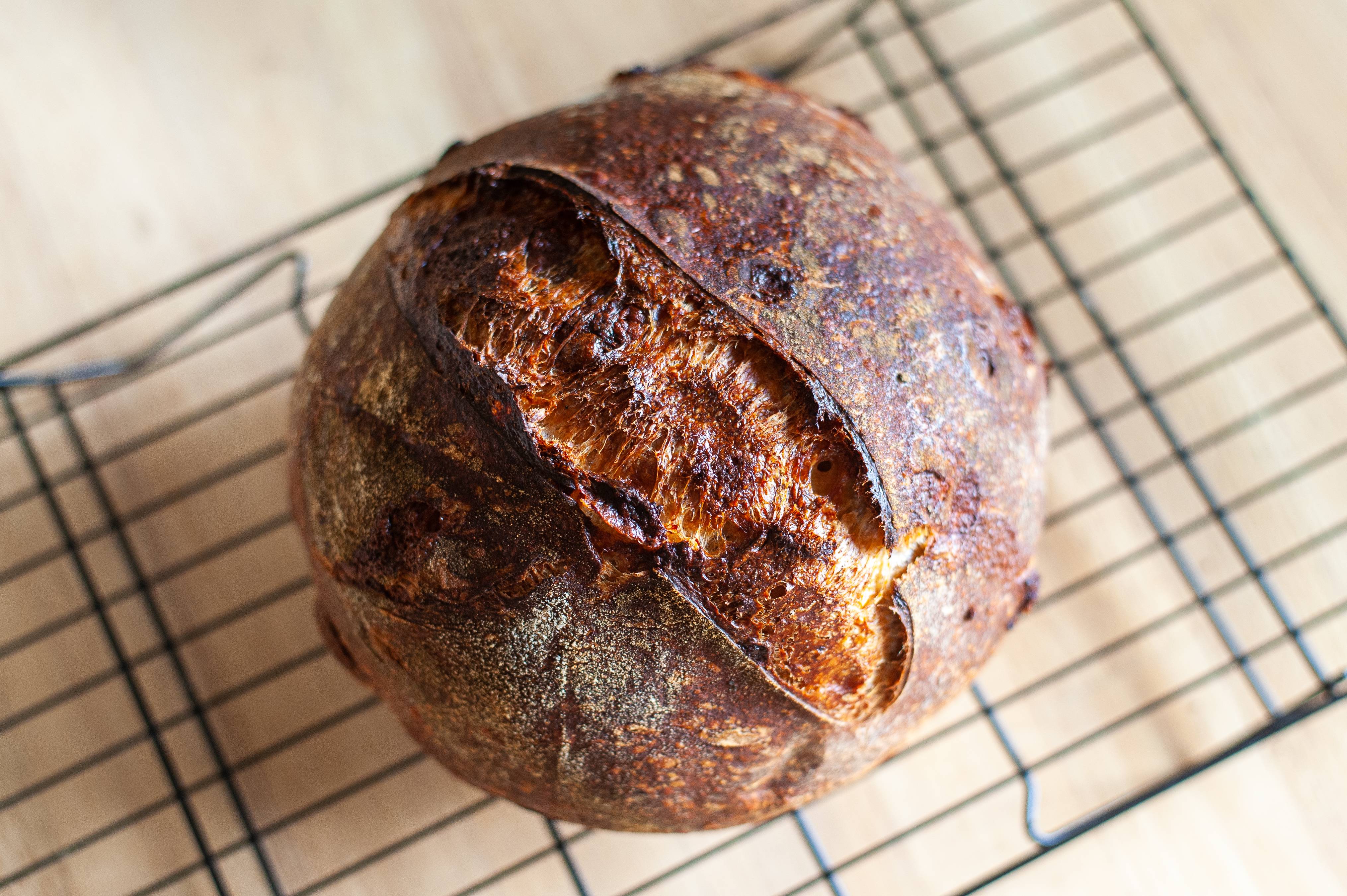
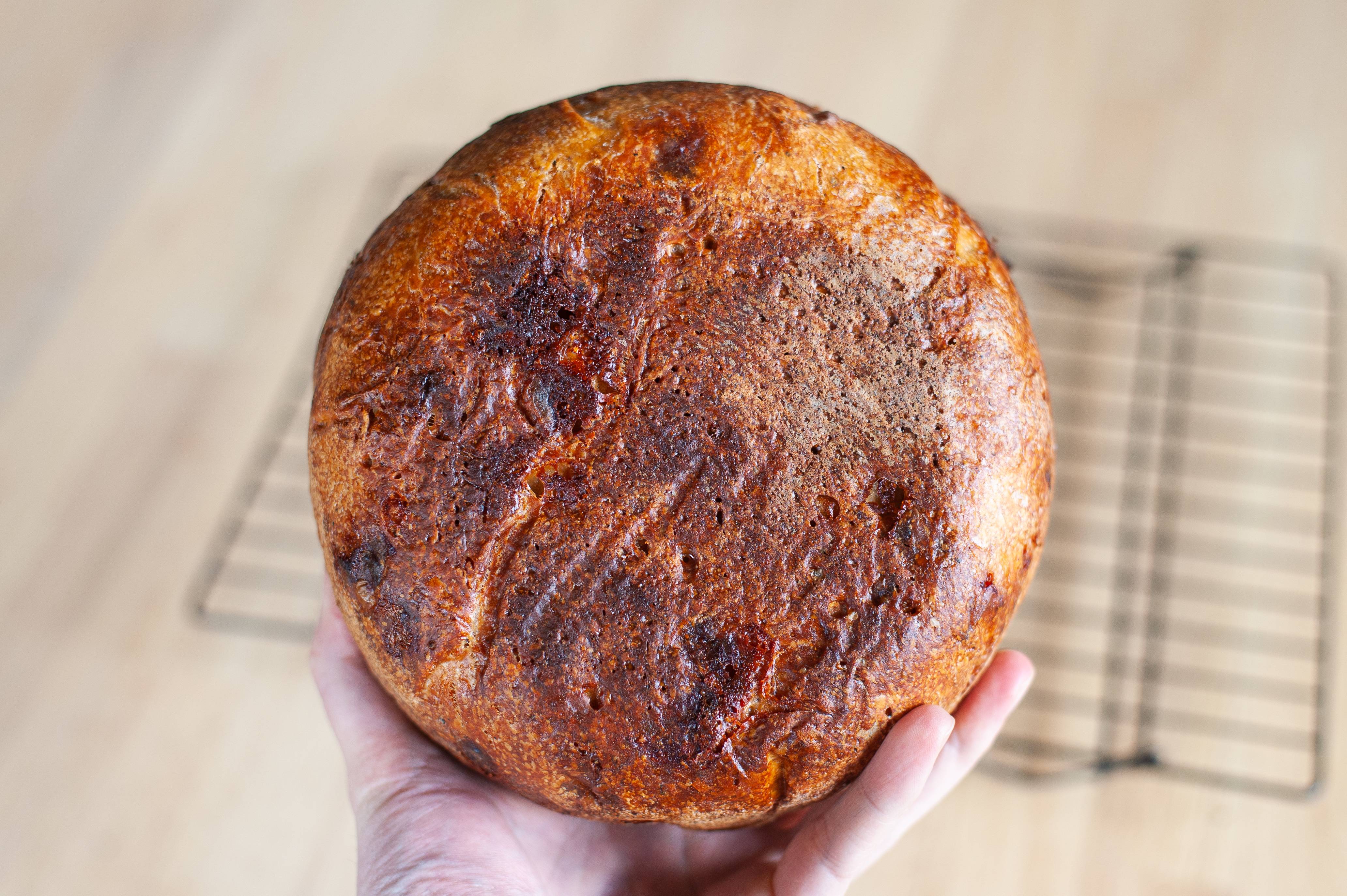
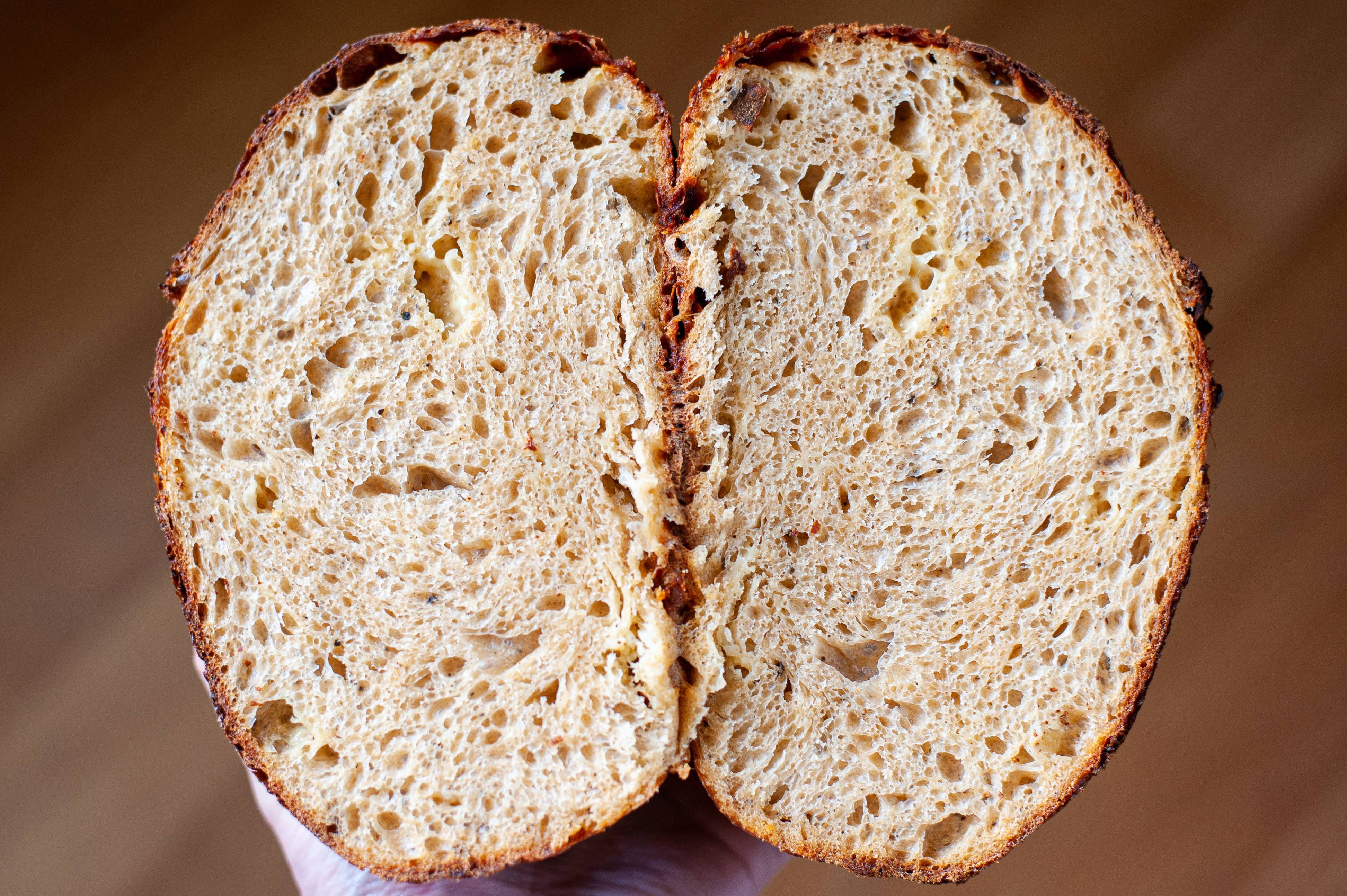
Same "quick" process as last time (no levain, no autolyse, 8hr bulk at room temp, 17 hours in fridge).




applescrap
Be the ball!
Welcome!Hey everyone. Somehow I didn't see this thread. I've been brewing for about 7 years and baking sourdough every weekend for the last year. Fun, complementary hobbies.
TandemTails
Well-Known Member
This is my take on @deadwolfbones cheddar and paprika loaf using the same "lazy" sourdough method.
Dough
* 450g bread flour
* 50g rye flour
* 375g water @ 90'F
* 100g unfed starter
* 11g sea salt
* 100g sharp cheddar, 1/4" diced
* 2 tsp paprika
The cheddar was really well mixed throughout the loaf and you get a burst of cheddar in almost every bite. The paprika gives it a unique flavor that I really enjoy. The color from both the cheese and paprika gives the loaf a really nice orange/copper color.
My full recipe with photos and complete timetable are here: https://alegrebread.com/2020/04/06/cheddar-cheese-and-paprika-sourdough/
Some bonus pics:


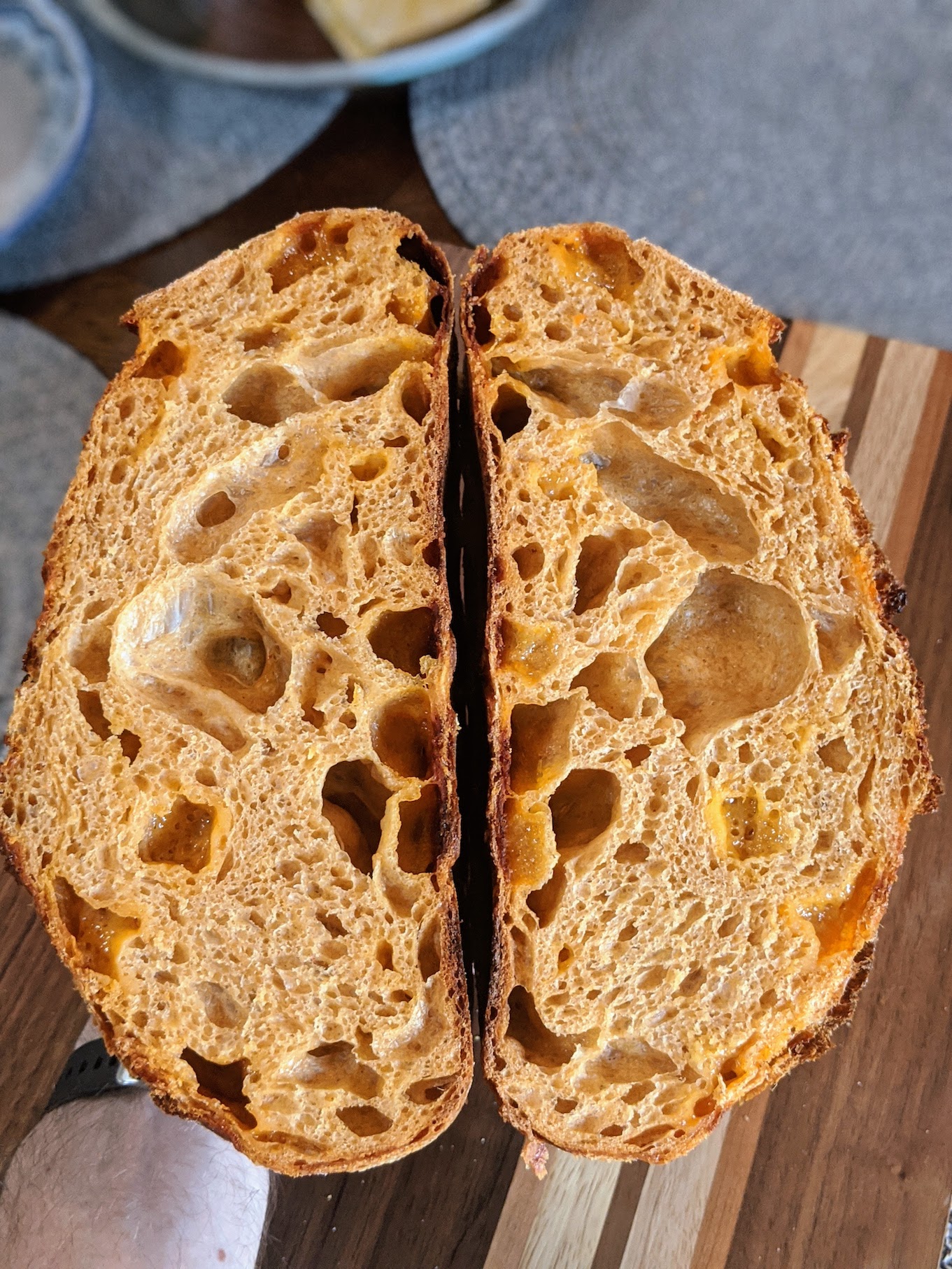
Dough
* 450g bread flour
* 50g rye flour
* 375g water @ 90'F
* 100g unfed starter
* 11g sea salt
* 100g sharp cheddar, 1/4" diced
* 2 tsp paprika
The cheddar was really well mixed throughout the loaf and you get a burst of cheddar in almost every bite. The paprika gives it a unique flavor that I really enjoy. The color from both the cheese and paprika gives the loaf a really nice orange/copper color.
My full recipe with photos and complete timetable are here: https://alegrebread.com/2020/04/06/cheddar-cheese-and-paprika-sourdough/
Some bonus pics:



jswillbrewforbeer
Well-Known Member
First traditional sourdough


Similar threads
- Replies
- 7
- Views
- 1K
- Replies
- 4
- Views
- 1K











![Craft A Brew - Safale BE-256 Yeast - Fermentis - Belgian Ale Dry Yeast - For Belgian & Strong Ales - Ingredients for Home Brewing - Beer Making Supplies - [3 Pack]](https://m.media-amazon.com/images/I/51bcKEwQmWL._SL500_.jpg)



























